Liang dynasty
The Liang dynasty (Chinese: 梁朝; pinyin: Liáng cháo) (502–557), also known as the Southern Liang (Chinese: 南梁; pinyin: Nán Liáng), was the third of the Southern Dynasties during China's Southern and Northern Dynasties period. It was located in South China and succeeded by the Chen dynasty in 557. The small rump state Western Liang (555–587), located in Central China, continued until it was destroyed in 587 by the Sui dynasty.
Liang 梁 | |||||||||||||||
|---|---|---|---|---|---|---|---|---|---|---|---|---|---|---|---|
| 502–557 | |||||||||||||||
 Liang with West Wei and East Wei | |||||||||||||||
| Capital | Jiankang (502–552, 555–557) Jiangling (552–555) | ||||||||||||||
| Government | Monarchy | ||||||||||||||
| Emperor | |||||||||||||||
• 502–549 | Emperor Wu of Liang | ||||||||||||||
• 549–551 | Emperor Jianwen of Liang | ||||||||||||||
• 552–555 | Emperor Yuan of Liang | ||||||||||||||
• 555–557 | Emperor Jing of Liang | ||||||||||||||
| History | |||||||||||||||
• Established | 30 April[1] 502 | ||||||||||||||
| 24 April 549[2] | |||||||||||||||
| 7 January 555[3] | |||||||||||||||
| 16 November 557 | |||||||||||||||
• Disestablished | 16 November 557 | ||||||||||||||
| Currency | Chinese cash coins (Taiqing Fengle cash coins) | ||||||||||||||
| |||||||||||||||
| Today part of | China Vietnam | ||||||||||||||
Rule
During the Liang dynasty, in 547 a Persian embassy paid tribute to the Liang, amber was recorded as originating from Persia by the Book of Liang.[4]
In 548, Hou Jing Prince of Henan started a rebellion with Xiao Zhengde the Prince of Linhe, nephew and a former heir of Emperor Wu of Liang and installed Xiao Zhengde as emperor. In 549, Hou sacked Jiankang, deposed and killed Xiao Zhengde, seized the power and put Emperor Wu effectively under house arrest. He dismissed the armies opposed to him in the name of Emperor Wu. In 550 Emperor Wu died, Hou created Emperor Wu's third son Crown Prince Gang Emperor Jianwen of Liang, also effectively under house arrest. He also attempted to suppress those who would not submit to him.
At the same time the Liang princes fought with each other rather than try to eliminate Hou: Emperor Wu's seventh son Xiao Yi Prince of Xiangdong killed his nephew Xiao Yu the Prince of Hedong, forcing Xiao Yu's younger brother Xiao Cha Prince of Yueyang to surrender to the Western Wei; Xiao Yi also attacked his sixth brother Xiao Guan Prince of Shaoling, forcing him to surrender to Northern Qi. Both Xiao Cha and Xiao Guan were created Prince of Liang. However, as Xiao Yi also allied with Northern Qi, Northern Qi gave up their support of Xiao Guan; Xiao Guan was defeated by Hou and finally killed by Western Wei. Xiao Ji the Prince of Wuling the youngest son of Emperor Wu claimed imperial title.
In 551, Hou forced Emperor Jianwen to abdicate to his grandnephew Xiao Dong the Prince of Yuzhang, then killed Emperor Jianwen and forced Xiao Dong to abdicate to him. Hou established a new dynasty named Han. In 552, Xiao Yi destroyed Han and claimed the imperial title as Emperor Yuan of Liang. He also ordered his subordinates to kill Xiao Dong and Xiao Dong's younger brothers. He created his headquarter Jiangling capital instead of returning to Jiankang. He also managed to eliminate Xiao Ji, but in order to do this he allied with Western Wei, who in turn conquered Yi Province (Sichuan).
In 553, Northern Qi attacked Liang, aiming to install a nephew of Emperor Wu, Xiao Tui the Marquess of Xiangyin, as emperor, but was defeated.
As the relationship between Emperor Yuan and Western Wei was deteriorating, in 555, Western Wei army sacked Jiangling, forcing Emperor Yuan to surrender, and killed Emperor Yuan as well as his sons before installing Xiao Cha as emperor of (Western) Liang at Jiangling.
Liang generals led by Wang Sengbian declared Xiao Fangzhi Prince of Jin'an, the only living son of Emperor Yuan, as Prince of Liang at Jiankang, aiming to crown him the new emperor, but the Northern Qi army defeated them, forcing them into an agreement to recognise a nephew of Emperor Wu, Xiao Yuanming the Marquess of Zhenyang, as emperor instead. Wang requested that Xiao Fangzhi be created Crown Prince and Xiao Yuanming agreed. General Chen Baxian launched a raid that killed Wang in favor of Xiao Fangzhi while denouncing Wang for surrendering to Northern Qi. Xiao Yuanming was forced to abdicate to Xiao Fangzhi, who was known as Emperor Jing of Liang, and Chen seized power. He initially claimed Liang a subject of Northern Qi but later defeated the army of Northern Qi.
In 557, Chen Baxian established the new powerful Chen dynasty. Liang general Wang Lin also claimed Xiao Zhuang Prince of Yongjia grandson of Emperor Yuan emperor. In 560, the Chen dynasty defeated Xiao Zhuang who fled to the Northern Qi and was created Prince of Liang in 570. The small and weak Western Liang state existed until 587 when Sui dynasty destroyed it.
Emperors
| Posthumous Name | Personal Name | Period of Reigns | Era names |
|---|---|---|---|
| Emperor Wu of Liang | Xiao Yan | 502–549[note 1] | Tianjian (天監) 502–519 Putong (普通) 520–527 Datong (大通) 527–529 Zhongdatong (中大通) 529–534 Datong (大同) 535–546 Zhongdatong (中大同) 546–547 Taiqing (太清) 547–549 |
| Emperor Jianwen of Liang | Xiao Gang | 549–551 | Dabao (大寶) 550–551 |
| – | Xiao Dong | 551–552 | Tianzheng (天正) 551-552 |
| Emperor Yuan of Liang | Xiao Yi | 552–555[note 2] | Chengsheng (承聖) 552–555 |
| – | Xiao Yuanming | 555 | Tiancheng (天成) 555 |
| Emperor Jing of Liang | Xiao Fangzhi | 555–557[note 3] | Shaotai (紹泰) 555–556 Taiping (太平) 556–557 |
Rulers' family tree
| Liang dynasty and Western Liang | ||||||||||||||||||||||||||||||||||||||||||||||||||||||||||||||||||||||||||||||||||||||||||||||||||||||||||||||||||||||||||||||||||||||||||||||||||||||||||||||||||||||||||||||||||||||||||||||||||||||||||||||||||||||||||||||||||||||||||||||||||||||||||||||||||||||||||||||||||||||||||||||||||||||||||||||||||||||||||||||||||||||||||||||||||||||||||||||||||||||||||||||||||||||||||||||||||||||||||||||||||||||||||||||||||||||||||||||||||||||||||||||||||||||||||||||||||||||||||||||||||||||||||||||||||||||||||||||||||||||||||||||||||||||||||||||||||||||||||||||||||||||||||||||||||||||||||||||||||||||||||||||||||||||||||||||||||||||||||||||||||||||||||||||||||||||||||||||||||||||||||||||||||||||||||||||||||||||||||||||||||||||||||||||||||||||||||||||||||||||||||||||||||||||||||||||||||||||||||||||||||||||||||
|---|---|---|---|---|---|---|---|---|---|---|---|---|---|---|---|---|---|---|---|---|---|---|---|---|---|---|---|---|---|---|---|---|---|---|---|---|---|---|---|---|---|---|---|---|---|---|---|---|---|---|---|---|---|---|---|---|---|---|---|---|---|---|---|---|---|---|---|---|---|---|---|---|---|---|---|---|---|---|---|---|---|---|---|---|---|---|---|---|---|---|---|---|---|---|---|---|---|---|---|---|---|---|---|---|---|---|---|---|---|---|---|---|---|---|---|---|---|---|---|---|---|---|---|---|---|---|---|---|---|---|---|---|---|---|---|---|---|---|---|---|---|---|---|---|---|---|---|---|---|---|---|---|---|---|---|---|---|---|---|---|---|---|---|---|---|---|---|---|---|---|---|---|---|---|---|---|---|---|---|---|---|---|---|---|---|---|---|---|---|---|---|---|---|---|---|---|---|---|---|---|---|---|---|---|---|---|---|---|---|---|---|---|---|---|---|---|---|---|---|---|---|---|---|---|---|---|---|---|---|---|---|---|---|---|---|---|---|---|---|---|---|---|---|---|---|---|---|---|---|---|---|---|---|---|---|---|---|---|---|---|---|---|---|---|---|---|---|---|---|---|---|---|---|---|---|---|---|---|---|---|---|---|---|---|---|---|---|---|---|---|---|---|---|---|---|---|---|---|---|---|---|---|---|---|---|---|---|---|---|---|---|---|---|---|---|---|---|---|---|---|---|---|---|---|---|---|---|---|---|---|---|---|---|---|---|---|---|---|---|---|---|---|---|---|---|---|---|---|---|---|---|---|---|---|---|---|---|---|---|---|---|---|---|---|---|---|---|---|---|---|---|---|---|---|---|---|---|---|---|---|---|---|---|---|---|---|---|---|---|---|---|---|---|---|---|---|---|---|---|---|---|---|---|---|---|---|---|---|---|---|---|---|---|---|---|---|---|---|---|---|---|---|---|---|---|---|---|---|---|---|---|---|---|---|---|---|---|---|---|---|---|---|---|---|---|---|---|---|---|---|---|---|---|---|---|---|---|---|---|---|---|---|---|---|---|---|---|---|---|---|---|---|---|---|---|---|---|---|---|---|---|---|---|---|---|---|---|---|---|---|---|---|---|---|---|---|---|---|---|---|---|---|---|---|---|---|---|---|---|---|---|---|---|---|---|---|---|---|---|---|---|---|---|---|---|---|---|---|---|---|---|---|---|---|---|---|---|---|---|---|---|---|---|---|---|---|---|---|---|---|---|---|---|---|---|---|---|---|---|---|---|---|---|---|---|---|---|---|---|---|---|---|---|---|---|---|---|---|---|---|---|---|---|---|---|---|---|---|---|---|---|---|---|---|---|---|---|---|---|---|---|---|---|---|---|---|---|---|---|---|---|---|---|---|---|---|---|---|---|---|---|---|---|---|---|---|---|---|---|---|---|---|---|---|---|---|---|---|---|---|---|---|---|---|---|---|---|---|---|---|---|---|---|---|---|---|---|---|---|---|---|---|---|---|---|---|---|---|---|---|---|---|---|---|---|---|---|---|---|---|---|---|---|---|---|---|---|---|---|---|---|---|---|---|---|---|---|---|---|---|---|---|---|---|---|---|---|---|---|---|---|---|---|---|---|---|---|---|---|---|---|---|---|---|---|---|---|---|---|---|---|---|---|---|---|---|---|---|---|---|---|---|---|---|---|---|---|---|---|---|---|---|---|---|---|---|---|---|---|---|---|---|---|---|---|---|---|---|---|---|---|---|---|---|---|---|---|---|---|---|---|---|---|---|---|---|---|---|---|---|---|---|---|---|---|---|---|---|---|---|---|---|---|---|---|---|---|---|---|---|
|
- Liang emperors - Western Liang emperors - Liang throne pretenders
| ||||||||||||||||||||||||||||||||||||||||||||||||||||||||||||||||||||||||||||||||||||||||||||||||||||||||||||||||||||||||||||||||||||||||||||||||||||||||||||||||||||||||||||||||||||||||||||||||||||||||||||||||||||||||||||||||||||||||||||||||||||||||||||||||||||||||||||||||||||||||||||||||||||||||||||||||||||||||||||||||||||||||||||||||||||||||||||||||||||||||||||||||||||||||||||||||||||||||||||||||||||||||||||||||||||||||||||||||||||||||||||||||||||||||||||||||||||||||||||||||||||||||||||||||||||||||||||||||||||||||||||||||||||||||||||||||||||||||||||||||||||||||||||||||||||||||||||||||||||||||||||||||||||||||||||||||||||||||||||||||||||||||||||||||||||||||||||||||||||||||||||||||||||||||||||||||||||||||||||||||||||||||||||||||||||||||||||||||||||||||||||||||||||||||||||||||||||||||||||||||||||||||||
Portraits of Periodical Offering of Liang
The Portraits of Periodical Offering of Liang by the Emperor Yuan of Liang, Xiao Yi, dated to the 6th century, is the earliest surviving of these specially significant paintings. They reflect foreign embassies that took place, particularly regarding the three Hephthalite (Hua) ambassadors, in 516–520 CE.[5][6] The original of the work was lost, and the only surviving edition of this work was a copy from the Song dynasty in the 11th century, and is currently preserved at the National Museum of China. The original work consisted of at least twenty five portraits of ambassadors from their respectively country. The copy from the Song dynasty has twelve portraits and descriptions of thirteen envoys, with the envoy from Dangchang missing a portrait.[7]
The envoys from right to left were: the Hephthalites (滑/嚈哒), Persia (波斯), Korea (百濟), Kucha (龜茲), Japan (倭), Malaysia (狼牙脩), Qiang (鄧至), Yarkand (周古柯), Kabadiyan (呵跋檀), Kumedh (胡蜜丹), Balkh (白題), and Merv (末).[5][8][7]
Artistic heritage
Tombs of a number of members of the ruling Xiao family, with their sculptural ensembles, in various states of preservation, are located near Nanjing.[9] The best surviving example of the Liang dynasty's monumental statuary is perhaps the ensemble of the Tomb of Xiao Xiu (475–518), a brother of Emperor Wu, located in Qixia District east of Nanjing.[10][11]
- Tombs of the Liang Dynasty
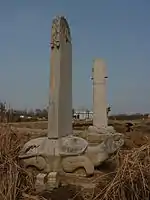 A turtle-borne stele and a pillar; tomb of Xiao Hong
A turtle-borne stele and a pillar; tomb of Xiao Hong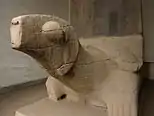 A turtle-borne stele; tomb of Xiao Dan
A turtle-borne stele; tomb of Xiao Dan A bixie (winged lion); tomb of Xiao Hui
A bixie (winged lion); tomb of Xiao Hui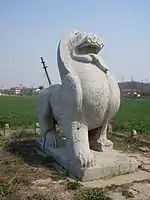 A bixie near the tomb of Xiao Jing, widely regarded as Nanjing's icon
A bixie near the tomb of Xiao Jing, widely regarded as Nanjing's icon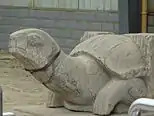 A stele-bearing turtle; tomb of Xiao Xiu
A stele-bearing turtle; tomb of Xiao Xiu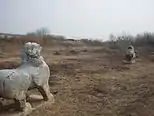 Two bixies near the tomb of Xiao Zhengli
Two bixies near the tomb of Xiao Zhengli
See also
- King of Liang
- Chen dynasty
- Book of Liang
- History of Northern Dynasties
- History of Southern Dynasties
- Zizhi Tongjian
Notes
- Emperor Wu's nephew Xiao Zhengde the Prince of Linhe, who joined Hou Jing's rebellion, was declared emperor by Hou in 548, but after Hou's victory over Emperor Wu in 549 was deposed and killed by Hou, and is not usually considered a true emperor.
- Emperor Yuan's brother Xiao Ji the Prince of Wuling also declared himself emperor in 552, but was defeated and killed by Emperor Yuan in 553, and is usually not considered a true emperor.
- In 558, a year after Emperor Jing had yielded the throne to Chen Baxian (and had been killed by Chen), his nephew Xiao Zhuang the Prince of Yongjia, with support from Northern Qi, was proclaimed the emperor of Liang by the general Wang Lin. In 560, Wang Lin defeated the Chen troops, and both he and Xiao Zhuang were forced to flee to Northern Qi. It is a matter of controversy whether Xiao Zhuang should be considered an emperor of Liang.
References
- Zizhi Tongjian, vol. 145.
- Zizhi Tongjian, vol. 162.
- Book of Liang, vol. 5.
- Maurice Fishberg (1907). Materials for the physical anthropology of the eastern European Jews, Issues 1-6 (reprint ed.). New Era Print. Co. p. 233. Retrieved 12 June 2011.
- DE LA VAISSIÈRE, ÉTIENNE (2003). "Is There a "Nationality of the Hephtalites"?". Bulletin of the Asia Institute. 17: 127-128. ISSN 0890-4464. JSTOR 24049310.
- DE LA VAISSIÈRE, ÉTIENNE (2003). "Is There a "Nationality of the Hephtalites"?". Bulletin of the Asia Institute. 17: 130, note 31. ISSN 0890-4464.
- Lung, Rachel. Interpreters in Early Imperial China. John Benjamins Publishing. pp. 29, n.14, 99. ISBN 978-90-272-2444-6.
- Ge, Zhaoguang (Professor of History, Fudan University, China) (2019). "Imagining a Universal Empire: a Study of the Illustrations of the Tributary States of the Myriad Regions Attributed to Li Gonglin" (PDF). Journal of chinese humanities. 5: 128.
- "Mausoleum Stone Carvings of Southern Dynasties in Nanjing". chinaculture.org. Archived from the original on July 25, 2011.
- Albert E. Dien, «Six Dynasties Civilization». Yale University Press, 2007 ISBN 0-300-07404-2. Partial text on Google Books. P. 190. A reconstruction of the original form of the ensemble is shown in Fig. 5.19.
- 梁安成康王萧秀墓石刻 Archived 2013-10-19 at the Wayback Machine (Sculptures at the Tomb of Xiao Xiu) (in Chinese) (description and modern photos)
External links
 Media related to Liang Dynasty at Wikimedia Commons
Media related to Liang Dynasty at Wikimedia Commons
.jpg.webp)